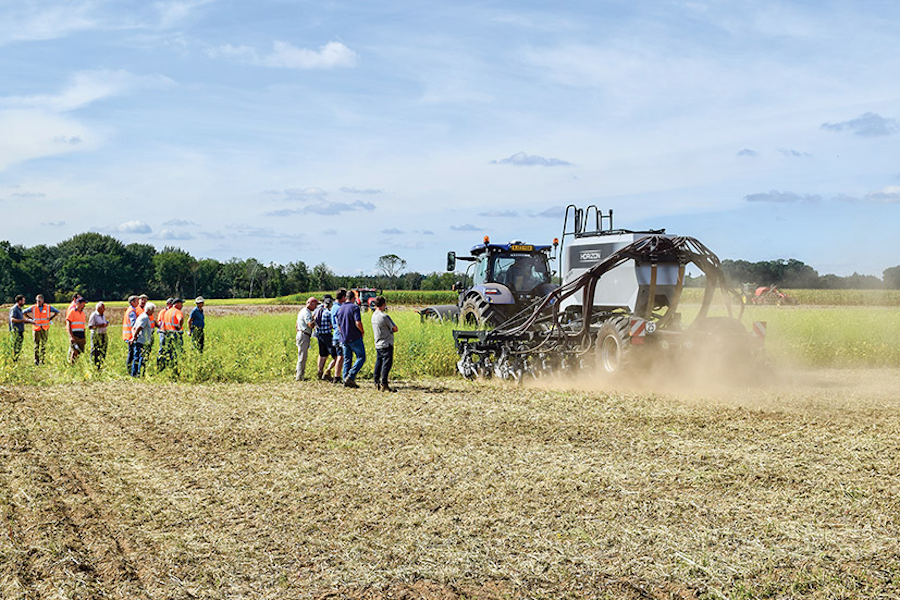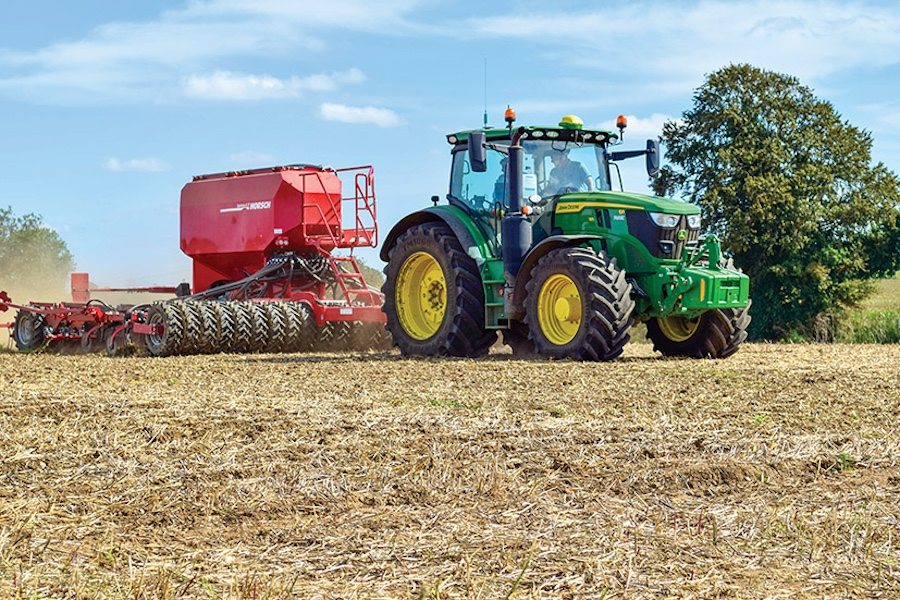Soil health takes centre stage at direct drilling demo
16th November 2023
Around 100 farmers from across East Anglia attended a recent demonstration day in Suffolk, where drills from leading manufacturers were put through their paces in a variety of establishment situations.

The event at Street Farm on Ampton Hall Estate, near Bury St Edmunds, was organised by agronomy firm Farmacy, and kindly hosted by Strutt & Parker (Farms) Ltd and the Turner family. It provided a stage to discuss the attributes of different machines in a range of situations, from bare stubble to green cover crops. The demonstration also centred on the importance of understanding soil properties to ensure any cultivation, drill, or management strategy was ‘fit for purpose’.
“The trial is not about finding out which drill is the best, it’s to show some of the areas that we as agronomists and farmers need to be thinking about,” said Farmacy agronomist, John Chamberlain.
“With more and more growers looking at, or now practicing, direct drilling, minimal tillage, low disturbance cultivations, cover crops and the like, there are so many permutations when it comes to establishing a crop. Drill technology is also advancing at quite a pace, and buying a new machine is a considerable investment, so we want to explore all of this in more detail to better understand what will – and won’t – work in different field situations.”

Six drills, six plots
The demonstration centred around a field-scale trial where each of the six drills (see box) was tasked to direct-sow KWS Serafino winter rye into six different seedbeds, which included:
- Bare rye stubble
- Low disturbance subsoil (Sumo LDS) and disc (Horsch Joker)
- Low disturbance subsoil only (Sumo LDS)
- Standing cover crop (MaxiCatchCrop – buckwheat, white mustard, berseem clover)
- Mown and sprayed off cover crop (MaxiCatchCrop)
- Ploughed and pressed
Mr Chamberlain said plots would be monitored throughout the season, with plant counts and other assessments conducted over the autumn and winter, before being harvested for forage next year to supply a local biogas plant.
Winter rye was specifically selected for the demonstration due to its sensitivity to drilling depth and pre-emergence herbicides, which should help to highlight any variations in drill performance, he noted.
Making soils work for you
Alongside the drill demonstration, growers also had the opportunity to look beneath the surface of the sandy loam soil at the farm, where Hutchinsons head of soils, Ian Robertson, stressed the importance of understanding soil chemistry to make soils function better for both crops and machinery.
“A lot of soil structure is driven by chemistry, so understanding that is key to getting your soil working effectively,” he said.
That was clearly illustrated by Terramap high-definition soil analysis of the demonstration area (known as ‘Keepers Field’), which explained why one part of the field had historically been harder to work than the rest.
“We initially thought it might be because of higher clay content in that area, but Terramap showed that while there were some small variations, the difference in workability was actually more due to the calcium to magnesium ratio,” Hutchinsons digital services specialist, James Lane explained.
“There was a much higher magnesium content in the bottom corner of the field, which was making soil in that area tighter, stickier and harder to work.”
The same area also recorded higher organic matter, but because the Ca:Mg ratio was out of balance, this had little impact on improving workability. Understanding those interactions meant targeted management measures could be put into place, he added.
Soil chemistry played a major role in the availability and cycling of nutrients too, Mr Robertson continued.
High pH soils, as in Keepers Field for example, were at greater risk of phosphate becoming locked-up in the soil, therefore in such situations, it was more effective to use small amounts of placement fertiliser with seed at drilling, rather than a broadcast surface application. All of the drills in the demonstration had the capacity to apply seed and microgranular compounds where required, with versatile hopper and metering systems.
Cover crop benefits
Another area Mr Robertson urged growers to focus on was the use of cover crops to improve soil conditions and “feed” the microbial activity needed to cycle nutrients effectively.
“Every soil has a ‘deep freeze’ of nutrients, and if we get it working well, soil will cycle those more efficiently and into an available form that plants can use.
“Microbial activity is one of the biggest factors influencing nutrient cycling, so it is vital we feed that activity and ‘pull’ nutrients out of the deep freeze by providing green cover throughout the year. It’s about getting soils to cycle nutrients better, not putting more on.”
Analysis of the MaxiCatchCrop that was sown in Keepers Field after this harvest and terminated in the first week of September, revealed that even though it had only been in the ground for a few weeks, the mix had made a significant contribution to nutrient cycling.
Some 17t/ha of fresh weight had been put on, which contained 77kg/ha of nitrogen, 946kg/ha of carbon, and valuable amounts of other macro and micro nutrients. For nitrogen alone, assuming around one-third of that total was available to the following crop, in monetary terms it was worth around £30/ha, which was a valuable saving, especially on lighter land where nutrient retention from applied fertilisers could be more challenging, Mr Robertson said.a
“The carbon benefit from the cover crop is also important. We only measured the above ground biomass, but don’t forget about all of the sugars, carbohydrates and lipids cycling beneath the surface to feed microbial activity.”
The diverse root growth of mixed species cover crops was also a valuable tool for improving soil structure, especially on the high sand content soil, which could be at risk of becoming “tight” in a direct drilling situation.
When examining the soil profile, Mr Robertson noted a clearly defined surface layer of darker soil, high in organic matter within the top 30cm; however, beneath that, soil was less friable, drier, lighter in appearance, and lacked the same organic matter and worm activity as the upper layer (see image on first page).
“Ideally, we don’t want to see distinct joints between layers of the soil; it should be more of a murky transition as roots and worms help penetrate layers and mix material around. The best way to manage soils in this way is to put as many living roots in there as possible.”
Additionally, roots helped to manage water throughout the profile, as living plants pulled water up from depth, and additional organic matter benefitted water retention – something that was particularly important on lighter, sandier soils, he added.

The six drills on show at the Farmacy demonstration included:
- Horsch Avatar 6-16SD
- Horsch Sprinter 6ST
- Horizon DSX 60-20
- Mzuri Pro-Til 4T
- John Deere 750A ProSeries Opener
- Vaderstad Proceed (original prototype)


